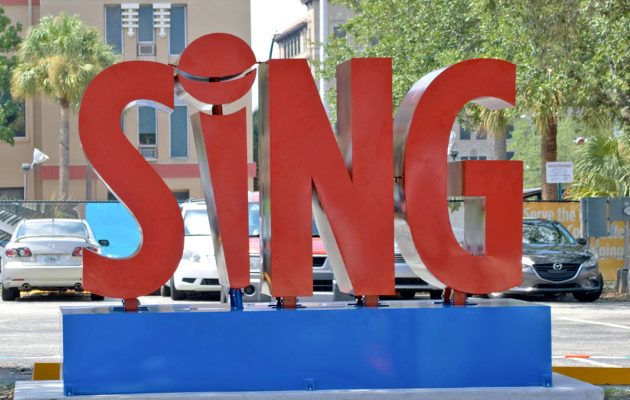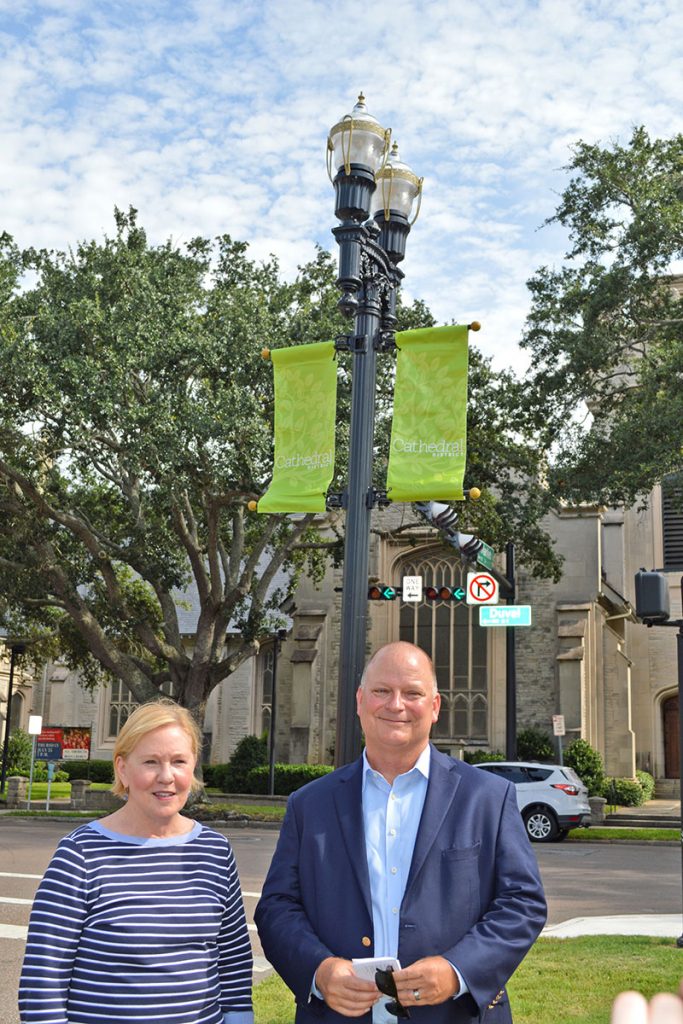New Cathedral District has forward-thinking plan for community growth

It has been several years in the making, but the plan that was shaped through heartfelt conversations between a priest and a parishioner is poised to revive the Cathedral District, perpetuating a sense of place with love at its core.
Soon after The Very Rev. Kate Moorehead, dean of St. John’s Cathedral, arrived in Jacksonville nine years ago, she began regularly meeting church member Ginny Myrick for breakfast. The two talked about their faith, their families, and their thoughts on how to bring a fresh sense of purpose to the highest point in the City – the area known as the Cathedral District.
Through the years, various influential people often joined them for breakfast to discuss the plan. But nothing was happening, because no one was dedicating their efforts full time to making it happen, according to Moorehead. The spirit of the plan became substance shortly after Myrick decided to bring in the Urban Land Institute (ULI), a worldwide network of cross-disciplinary real estate and land use experts, to help them determine how to move forward with the plan.
The ULI brought in urban planners and architects from all over the nation. They received information on the area’s demographics, economic data and various maps identifying the study area, existing land use, zoning, bus routes, and downtown plans. At the conclusion of their two-day assessment, ULI recommended a road map of 34 things that needed to happen. Priority one was to birth a nonprofit devoted to urban development with someone at its helm fulltime.
“That was when I looked at Ginny and said, ‘I think that person is you.’ That is how Cathedral District-Jax was formed,” said Moorehead.

Moorehead had a vision of modeling the district after the cathedrals and surrounding villages in the Middle Ages. During those times, it often took a century to build a cathedral and a village would start growing up around it. “You’d have craftsmen, businesspeople, architects and the people that fed them and soon you’d have a whole village,” she said. “So, it struck me that we didn’t need to look very far in our own history to see a model of a cathedral being a heartbeat of a village and what we really needed was a neighborhood – we needed a village around us again. We needed people moving back downtown.”
The Cathedral District, so named for the five historic churches that anchor the neighborhood, is comprised of 118 acres and 36 blocks. The District extends north to south from State Street to Adams Street and east to west from Main Street to N. Liberty Street. It embraces five historic houses of worship, including the St. John’s Cathedral, First Presbyterian Church, First United Methodist Church, the Basilica of the Immaculate Conception, and Historic Mt. Zion A.M.E.
“There are 2,000 people that come downtown to these five churches every week and then they all go home. There is no place for them to live – the residency doesn’t exist and there is no place for them to eat – no restaurants exist, so there is no reason for them to stay,” said Myrick, CEO and president of Cathedral District-Jax (CDJ).
Myrick took the first step to remedy the situation by approaching the Episcopal Church Building Fund (ECBF) to seek financing for the plan. ECBF loans are available to Episcopal Church congregations for building and renovation projects for churches, schools, rectories and expansions of ministry projects.
“When we brought them this idea that we had 118 acres and 36 blocks of property that we are trying to redevelop they said, ‘Well, how are you going about that?’ I said, ‘I’m glad you asked because I have a block and a half I want to buy,’” Myrick said.
The block and a half Myrick referred to includes the long-vacated Community Connections building, which once served as transitional housing for homeless women and children. The nonprofit closed in 2017 after its primary source of funding, the U.S. Department of Housing and Development, reallocated those dollars to permanent housing solutions.
ECBF came to town and studied the Cathedral District. They looked at the master plan, they looked at what ULI had determined and they interviewed the CDJ board. After a long period of negotiation, they decided to loan CDJ the money to buy the property.
“Now they are using us as their national model of how to revive core city churches. They held their annual national meeting in Jacksonville four or five months ago. I made a big presentation to them and their board was mesmerized by it,” said Myrick. “They are part of a national organization that has been around since the 1800s. They have a very substantial endowment and lend money at very favorable terms for projects that have to do with inner-city Episcopal Church-related projects.”
As soon as CDJ got the title to the property, Myrick sent out a request for proposal (RFP) to look for a developer to build apartments for workforce housing. CDJ is working with Vestcor on a $20 million project to transform the old Community Connections property into a mixed-income housing development, Lofts at the Cathedral.
Although Gov. Ron DeSantis struck $8 million in funding from the state budget for workforce housing in the Cathedral District in late June, his proverbial red pen has not deterred plans to move forward with the project in the downtown neighborhood.
“It’s unfortunate that the $8 million affordable housing appropriation for Jacksonville was vetoed. It would have assisted the continued good work of building affordable housing downtown. The direct City allocation was for all of downtown and would have been bid competitively. Cathedral District-Jax is confident the sale of our Community Connections property will proceed as planned,” Myrick said.
At present, there are four announced residential projects in the planning and funding stages in the Cathedral District, including Lofts at the Cathedral, amounting to approximately 303 new apartments and $41.8 million in economic investment. The district now houses over 650 seniors and has 52 market rate townhomes.
The other three residential projects are Jacksonville developer Rafael Caldera’s estimated $5.6 million project on a 0.75 acre lot at Duval and Washington streets, comprised of 45 multifamily housing units and 27,000 square feet of gallery and studio space; JWB Real Estate Capital’s three-story, 18-unit metal storage container housing development located along Ashley Street near Liberty Street, and Ashley Square, a $20 million project of Blue Sky Communities of Tampa. Ashley Square, to be located at the corner of Ashley and Beaver Streets, will be comprised of a five-story apartment building that will have 110 one- and two-bedroom units for working adults and seniors.
Plans to revitalize the district include businesses, a K-8 charter school, public art, employment opportunities and more, but housing is the key to the kingdom.
“The rule of thumb in economic development is retail follows rooftops. So, if you get enough critical mass of residential, you will get people that will be able to go to a coffee shop or go to a restaurant,” said Myrick. “If you add the 2,000 that come to the Cathedral District for church every Sunday, you’ve got something going on.”
The recently installed light pole banners that wave through the Cathedral District are further heralding the good news of a neighborhood nearing transfiguration. Designed by Cathedral District-Jax, Inc., the 108 banners were printed and hung on the historic lampposts by the Downtown Investment Authority (DIA).
“If anybody doesn’t know where the Cathedral District is, now that we’ve got some branding, they will drive through these streets and understand what is meant when we talk about the Cathedral District in this Northeast section of Downtown Jacksonville,” said Steven Kelley, CDJ board chair. “We are very excited that the City has supported us in our efforts with these beautiful banners.”
Further punctuating the positive change going on in the Cathedral District is a public art installation that was unveiled by the Jacksonville Children’s Chorus (JCC) Aug. 9, in celebration of its upcoming 25th anniversary. The sculpture, which sits near the parking lot across from the First United Methodist Church at 225 E. Duval St., where JCC has its headquarters, spells out S-I-N-G in bold red letters that sit atop a blue base.
“It’s taken a long time to get to this point. This unveiling is the beginning of several artistic creations that are being commissioned by the JCC. Some are musical compositions, some are in concert formats, some will be improvements to our facilities. Others will be surprises,” said Heather Solanka, JCC chair.
The sculpture was funded in part by a neighborhood grant and in part by a generous donation from Preston Haskell, according to Solanka. The sculpture was created by artist and UNF fine arts professor Jenny Hager and was based on the design by graphic designer Carolyn Audije, who has served the JCC in a variety of capacities over the last several years.
“We are excited to be a part of the revitalization of the Cathedral District,” said Audije. “We look forward to seeing all that is to come.”
During the month of December, the five churches in the Cathedral District will host the Cathedral District Festival of Lights and Music, coordinated by Linda Crofton, CDJ’s director of community development. Caroling choirs, Christmas lights and decorations, docent-led tours of the churches, and hot cocoa and refreshments will be part of the celebration. More details will be released as the date draws closer.
“Our neighborhood is a genteel, safe and historically spiritually-significant area of Jacksonville, and that’s why it’s safe – because it’s surrounded by five churches and they are all churches that are involved in the community, that care about their community, and care about the people around them,” Crofton said.
Crofton is also working on establishing a neighborhood association for the Cathedral District, similar to Riverside Avondale Preservation and San Marco Preservation Society.
“The crime rate in this area is very low. The reason for that is there is not a lot of people here; in our district, half of the land is surface parking lots. That’s a lot of empty space and empty space tends to make people feel insecure, but that’s just a perception; in reality, it’s very safe,” said Moorehead. “The one thing that a person needs to be aware of when you live or work or walk around downtown is that you may get asked for money. I think this is a good lesson for everyone in America. We need to come up with our own understanding of how to help people more – help to give them food, a bus ticket or refer them to city ministries that already exist.
“Love at the core means love in the urban core, love in the core of our hearts – love is at the core of the gospel,” continued Moorehead. “It’s one of those wonderful themes that has a lot of reverberation to it – it has many levels of meaning. We are trying to bring love back to the urban core and grow the urban core. We believe that in time we will have a leafy, green residential neighborhood that’s diverse and exciting and has many income levels and many ministries, but also businesses and retail, and that there will be people that choose to live here because they enjoy the diversity, because they enjoy walking to work and to school and to entertainment. I have no doubt that there will be a village around the Cathedral.”
By Kandace Lankford
Resident Community News






